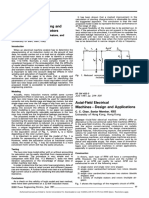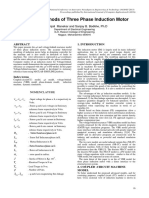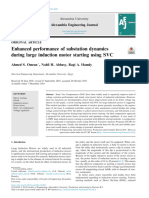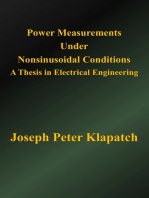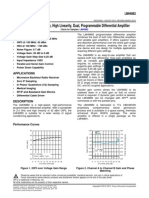A Simple Approach To Estimate The Steady-State Performance of Self-Excited Induction Generator
A Simple Approach To Estimate The Steady-State Performance of Self-Excited Induction Generator
Uploaded by
Ankita AroraCopyright:
Available Formats
A Simple Approach To Estimate The Steady-State Performance of Self-Excited Induction Generator
A Simple Approach To Estimate The Steady-State Performance of Self-Excited Induction Generator
Uploaded by
Ankita AroraOriginal Description:
Original Title
Copyright
Available Formats
Share this document
Did you find this document useful?
Is this content inappropriate?
Copyright:
Available Formats
A Simple Approach To Estimate The Steady-State Performance of Self-Excited Induction Generator
A Simple Approach To Estimate The Steady-State Performance of Self-Excited Induction Generator
Uploaded by
Ankita AroraCopyright:
Available Formats
WSEAS TRANSACTIONS on SYSTEMS and CONTROL K S Sandhu, Dheeraj Joshi
A Simple Approach to Estimate the Steady-State Performance
of Self-Excited Induction Generator
K S Sandhu, Dheeraj Joshi
Department of Electrical Engineering
National Institute of Technology
Kurukshetra,Haryana
INDIA
kjssandhu@yahoo.com, dheeraj_joshi@rediffmail.com
Abstract: This paper presents a new and simple model for the steady-state analysis of single and
parallel operated self-excited induction generators (SEIG). In this paper an attempt has been made
to incorporate the unjustified assumptions in an existing (Watsons) model. This has resulted into
an improved model for the estimation of performance of SEIG. A close agreement of simulated
results using proposed modeling with experimental values on test machines proves the validity
and superiority of proposed model. Further proposed model is extended for the analysis of a
system comprising of number of such machines operating in parallel.
Keywords: Parallel operation, steady state analysis, self-excited induction generator (SEIG),
wind energy conversion.
Nomenclature C at rated frequency
a per unit frequency Xm magnetizing reactance per
b per unit speed phase at rated frequency
Rc Core loss resistance
C terminal excitation
Sub
capacitance per phase
Im magnetizing current per 1. Introduction
phase Self-excited induction generators have
RL load resistance per phase attained a lot of attraction in recent years,
due to the suitability of these machines in
Rs stator resistance per phase many applications including wind energy
and small hydro energy systems. Further,
Rr rotor resistance per phase these machines and specially cage induction
V load voltage per phase machines pocesses many advantages such as
low cost, brushless and rugged construction,
Xs stator reactance per phase self protection capability etc.
To estimate the steady-state performance of
Xr rotor reactance per phase, a SEIG, most of the researchers used the
referred to stator conventional equivalent circuit
representation of an induction motor [1-13].
XC capacitive reactance due to Some of the researchers used the impedance
model, and a few used the admittance-based
ISSN: 1991-8763 Issue 3, Volume 3, March 2008
208
WSEAS TRANSACTIONS on SYSTEMS and CONTROL K S Sandhu, Dheeraj Joshi
model for the treatment of these circuits.
Whereas [10, 12] developed a new circuit
representation, which includes an active
power source in the rotor circuit. 2. Steady-State Analysis
Apart from this, [14] developed the simple
most approach to describe the autonomous
and parallel operation of self excited
induction generators. Simplicity is the main
attraction of Watsons [14] model.
Different models are suggested by
researchers for analysis and control of
parallel operated self-excited induction
generators in steady state. Al-Bahrani et al
[15] suggests Newton Raphson technique
for voltage control of two or more parallel
operated SEIG. Various control parameters
were found simultaneously. The results are Fig.1 Equivalent circuit representation.
better but with lengthy and complex terms.
Chakraborty et al [16,17] suggests T and Fig.1 shows the equivalent circuit as
inverse models for the analysis and adopted by Watson [14].
control of parallel operated SEIG. More This circuit representation may be modified
than one iterative loops were used to find the as given in Fig.2 with the provision of
various parameters. followings, which were found to be missing;
Sandhu [18] suggests a simple model having Inclusion of stator reactance
balanced resistive loads for the analysis of Inclusion of pu frequency to make
parallel operated SEIG. Methodology all leakage reactances and
adopted needs an estimation of capacitance excitation capacitance more
sharing by individual machine. Classical and effective.
conventional control techniques are Further magnetizing branch has
described by [19-20]. P. Haiguo et al [21] been shifted to stator side, as
presents an Fuzzy-PID based approach to usually adopted in motoring case.
control the wind turbine system. It is found
that the vector control in combination with
Fuzzy-PID control enhances the system
stability. Such developments are the
indication of current research in the area of
wind energy generation through induction
machines.
In the present paper an attempt has been
made to improve the results of [14] with few
modifications but without loosing the
simplicity of the approach. Close agreement
of simulated results with experimental
results, confirms the validity of proposed
modeling. Model is found to be suitable for Fig.2 Modified equivalent circuit.
the steady-state analysis of single as well as
for multi machine systems. Analysis of circuit as given in Fig.2, in
terms of real power gives;
ISSN: 1991-8763 Issue 3, Volume 3, March 2008
209
WSEAS TRANSACTIONS on SYSTEMS and CONTROL K S Sandhu, Dheeraj Joshi
V 2 V 2 Rearrangement of (5) and (6) results in to
k the quadratic equation in terms of unknown
a a
P= + (1) voltage as;
R s + Rr R L
a as a
k1V 2 + (k 2 aC )V + k 3 = 0 (7)
Where k is a fractional value and for a single Values of k1,k2 and k3 are as per Appendix 1.
machine is (1) to (7) may be used to determine the
R s Rr generated frequency and terminal voltage
+
a as for any operating speed and excitation
k= 1 capacitance. Further analysis of the
R R
2 2 generator including core loss is given in
s + r + ( X s + X r )2
a as Appendix 2.
This approach can be extended for N self
In the absence of power source (1) may be excited induction generators operating in
written as; parallel as shown in Fig.3.
Where
Rr
s= (2) N represents the number of machines
R s + kR L operating in parallel.
It can be also written as follows;
a b
s= (3)
a
Rotor speed and slip determines the
frequency of the generated voltage.
b
a= (4)
1 s
At no-load ( R L ), therefore the
generated frequency is same as the driven
frequency. However, as evident from above
expressions, generated frequency falls with
load.
For self-excitation, magnetizing current is
supplied by the capacitor and is given as;
I m = VaC (5)
Further, magnetization characteristics of
SEIG (Appendix-I) may be expressed in the
form as;
Im = k1V 2 + k2V + k3 (6)
ISSN: 1991-8763 Issue 3, Volume 3, March 2008
210
WSEAS TRANSACTIONS on SYSTEMS and CONTROL K S Sandhu, Dheeraj Joshi
s
R ri
i = (9)
i =1
R si + k i R L
a bi
si = (10)
a
b
a = i
(11)
1 si
I
i =1
mi = VaC (12)
and
I
i =1
mi = k1iV 2 + k 2iV + k 3i (13)
(8) to (13) may be used to estimate the
generated voltage and frequency as given in
Appendix-3.
3. Results and Discussions
TABLE 1 Comparison of results for
single machine.
Fig.3. Equivalent circuit representation of
parallel operated self-excited induction
generators.
Equation (1) to (7) referred to multi machine
system comprising of N such machines may
be modified as;
2 2
Table 1 gives the comparison of simulated
V V results with experimental results on a test
N ki
a a
P =
machine, SEIG-1 (Appendix 1). Simulated
+ (8)
R si R ri RL results with modifications as suggested in
i =1 +
a as i a this paper are found to be more close to
experimental one in comparison to
ISSN: 1991-8763 Issue 3, Volume 3, March 2008
211
WSEAS TRANSACTIONS on SYSTEMS and CONTROL K S Sandhu, Dheeraj Joshi
simulated results as obtained using Watson
model. This proves the validity and
superiority of the proposed modeling. Fig.4
to Fig.7 gives the variation of terminal
voltage and frequency with load for different
values of excitation capacitance and
operating speed. It is observed that
excitation capacitance at stator terminals and
operating speed of the machine effect the
performance to a great extent and thus may
be used to control the terminal conditions.
Fig.5. Variation of generated frequency with
load for different excitation capacitance.
Fig.4. Variation of terminal voltage with
load for different excitation capacitance.
Fig.6. Variation of terminal voltage with
load for different operating speed.
ISSN: 1991-8763 Issue 3, Volume 3, March 2008
212
WSEAS TRANSACTIONS on SYSTEMS and CONTROL K S Sandhu, Dheeraj Joshi
Fig.7. Variation of terminal voltage with Fig.8 Variation of generated frequency and
load for different operating speed. voltage with load.
TABLE 2 Comparison of results for two
machines operating in parallel.
C=90F ,RL=90
Table 2 gives the comparison of simulated
results with experimental results on a set of
two test machines [Appendix-1] operating in
parallel. Results are found to be in close
agreement especially for low slip operations,
justified in case of induction machines.
Fig.9 Variation of load ,generated frequency
and voltage with excitation capacitance.
Fig. 8 to Fig. 11 shows the simulated results
for a system comprising of two self excited
induction generators. As observed terminal
voltage falls sharply with load. However fall
of generated frequency with load is small in
comparison with the terminal voltage. This
reflects the necessacity to control the
ISSN: 1991-8763 Issue 3, Volume 3, March 2008
213
WSEAS TRANSACTIONS on SYSTEMS and CONTROL K S Sandhu, Dheeraj Joshi
terminal voltage with load variations. Fig.9 of parallel operation of two machines. It is
and Fig.10 shows the effect of excitation seen that generated voltage is greatly
capacitance and operating speed on the influenced due to any change of rotor
generated voltage, frequency and load resistance of one of the machines. However
supplied by two machine system operating variations in generated frequency are
in parallel. Load capability of the system negligible in case both machines are running
increases with an increase in excitation at constant speeds. This provides the
capacitance. However it effects the opportunity to control the generated voltage
generated voltage and frequency of the system through rotor resistance,
simultaneously. provided operating speeds are maintained.
4. Conclusion
In this paper an attempt has been made
to prepare a new model to investigate the
steady-state performance of single as
well as parallel operated self-excited
induction generators. The main
attraction of the model is its simplicity to
obtain the final solution. Results
obtained are found to be close agreement
to the experimental results obtained on a
test machine/set of machines. This
proves the validity of model proposed
Fig.10. Variation of load, generated for the analysis of single unit or number
frequency and voltage with rotor speed of of units operating in parallel. Efforts are
machine-2. made to include the core loss component
which is generally neglected. Inclusion
of core loss branch makes the model
more realistic. It is found that, to meet
the power needs of the world, wind
energy is emerging s a potential
candidate among renewable energy
resources. Therefore future research
plans of the authors in the area of wind
energy extraction using induction
generators is as;
Analysis and control of power
quality of wind energy systems
using artificial intelligence.
Fig.11. Variation of load, generated Design modifications in the
frequency and voltage with rotor resistance induction generators according to
of machine-2. operating constraints of a specific
area.
Fig.11 gives the effect of variations of rotor
resistance of machine-2 on the performance
ISSN: 1991-8763 Issue 3, Volume 3, March 2008
214
WSEAS TRANSACTIONS on SYSTEMS and CONTROL K S Sandhu, Dheeraj Joshi
References method, IEEE Trans. Energy
Conversion,vol.10 no. 3,1995,pp. 502-507.
[1] S. S. Murthy, O. P. Malik, and
[10] K. S. Sandhu and S. K. Jain,
A.K.Tandon, Analysis of self-excited
Operational aspects of self-excited
induction generators, Proc. IEE,vol. 129,pt.
induction generator using a new model,
C, no. 6,1982,pp. 260-265.
Electric Machines and Power Systems, vol.
27, no. 2,1999, pp. 169-180.
[2] G. Raina and O. P. Malik, Wind energy
conversion using a self-excited induction
[11] I. A. M. Abdel-Halim, M. A. Al-
generator, IEEE Trans. Power Apparatus
Ahmar, and M. Z. El-Sherif, A novel
and Systems, vol. PAS-102, no. 12,1983,pp.
approach for the analysis of self-excited
3933-3936.
induction generator, Electric Machines and
Power Systems, vol. 27,1999, pp. 879-888.
[3] A. K. Tandon, S. S. Murthy and C. S.
Jha, New method of computing steady-state
[12] K. S. Sandhu, Iterative model for the
response of capacitor self-excited induction
analysis of self-excited induction
generator, IE (I) Journal-EL, vol. 65,1985,
generators, Electric Power Components
pp. 196-201.
and Systems, vol. 31, no. 10, 2003, pp. 925-
939.
[4] N. H. Malik and S. E. Haque, Steady-
state analysis and performance of an isolated
[13] A. K .Tandon, S. S. Murthy, and G. J.
self-excited induction generator, IEEE
Berg, Steady-state analysis of capacitor
Trans. Energy Conversion, vol. EC-1, no.3,
self-excited induction generators, IEEE
1986,pp.134-139.
Trans.Power Apparatus and Systems, vol.
103, no. 3, 1984,pp 612-618.
[5] N. H. Malik and A. H. Al-Bahrani,
Influence of the terminal capacitor on the
[14] D.B. Watson and I.P. Milner,
performance characteristics of a self-excited
Autonomous and parallel operation of self
induction generator, Proc. IEE, vol.137, pt.
excited induction generator for lighting
C, no. 2, 1990, pp.168-173.
loads in remote areas, Int. J. Elect. Enging.
Educ., (22), 1985, 363-373.
[6] L. Shridhar, B. Singh, and C. S. Jha, A
step towards improvements in the
[15] A.H. Al-Bahrani and N.H. Malik,
characteristics of self-excited induction
Voltage Control of parallel operated self-
generator, IEEE Trans. Energy
excited induction generators, IEEE Trans.
Conversion, vol. 8, no. 1,1993,pp. 40-46.
Energy Conversion, Vol. 8, No. 2, June
1993, pp. 236-242.
[7] T. F. Chan, Steady-state analysis of
self-excited induction generators, IEEE
[16] C. Chakraborty, S. N. Bhadra, S.P. Das
Trans. Energy Conversion, vol. 9, no.
and A.K. Chattopadhyay, Some studies on
2,1994, pp.288-296.
the parallel operation of self excited
induction generators, Proc. IEE,vol. 129,pt.
[8] L. Quazene and G. McPherson,
C, no. 6,1982, pp. 361-366.
Analysis of the isolated induction
generator, IEEE Trans. Power Apparatus
[17] C. Chakraborty, S.N. Bhadra and A.K.
and Systems, vol. PAS-102, no. 8, 1983, pp.
Chattopadhyay, Analysis of parallel-
2793-2798.
operated self-excited induction generator,
IEEE Trans. Energy Conversion, vol. 14,
[9] T. F. Chan, Analysis of self-excited
No.2, June 1999, pp. 209-216.
induction generators using an iterative
ISSN: 1991-8763 Issue 3, Volume 3, March 2008
215
WSEAS TRANSACTIONS on SYSTEMS and CONTROL K S Sandhu, Dheeraj Joshi
[18] K. S. Sandhu, Steady-state analysis of Rs = 3.35 ohm
multimachine system with self-excited Rr = 1.76 ohm
induction generators, Electrical Power Xs = Xr = 4.85 ohm
Components and Systems, vol. 34, April
2006, pp. 483-496.
APPENDIX 2
[19] K.C. Wu, R.K. Joseph, N.K. Thupili,
Evaluation of classical and fuzzy logic
controllers for wind turbine yaw control,
Aerospace Control Systems, Proc. IEEE
Regional Conference, vol. 1, May 25-27,
1993, pp. 254-258.
[20] M. Namazov, R. Samet, R. Huseynov,
Modeling and Simulation of the fuzzy relay
type controller for solving the double
integrator control problem, Proc. Of 9th
WSEAS International Conference on
Automatic Control, Modeling & Simulation,
Istanbul, Turkey, vol.1, May 27-29, 2007, Fig.12. Modified equivalent circuit
pp.7-11. including core losses.
[21] P. Haiguo, W. Zhixin, Simulation Analysis of circuit as given in Fig.12, in
research of Fuzzy PID synthesis yaw vector terms of real power gives;
control system of wind turbine, WSEAS
Trans. on System and Control, Issue 10, vol. V 2 V 2 V 2
2, Oct. 2007, pp. 469-476. k
a a a
P= + +
APPENDIX 1 Rs + Rr Rc RL
a as a a
SPECIFICATIONS OF SEIG-1
Line voltage=380V Where k is a fractional value and depends
Line current=1.9A upon the design of the machine.
In the absence of power source may be
Rating=1.0HP
written as;
Number of poles= 4
Frequency=50Hz
Base speed =1500 rpm Rr
Rs = 9.5 ohm s=
k
Rr = 8.04 ohm Rs +
1 1
Xs = Xr = 8.84 ohm a +
c
R R L
SPECIFICATIONS OF SEIG-2
Line voltage=230V
Line current=4.96A
Rating=3.0HP
Frequency=50Hz
Number of poles= 4
Base speed =1500 rpm
ISSN: 1991-8763 Issue 3, Volume 3, March 2008
216
WSEAS TRANSACTIONS on SYSTEMS and CONTROL K S Sandhu, Dheeraj Joshi
TABLE 2 Simulated results including
core losses. N6=n32*d31+n22*d41;
P6=kk*(d41*d12+d31*d22+d21*d32+d1
1*d42);
Q5=M5+N5+P5;
M5=n31*d22+n21*d32+n11*d42;
N5=n32*d21+n22*d31+n21*d41;
P5=kk*(d41*d02+d31*d12+d21*d22+d1
1*d32+d01*d42);
Q4=M4+N4+P4;
APPENDIX 3 M4=n31*d12+n21*d22+n11*d32;
Generated frequency for two machine N4=n32*d11+n22*d21+n12*d31;
systems including core losses may be
calculated using (8) and (10). This results P4=kk*(d31*d02+d21*d12+d11*d22+d0
into the solution of 9th order polynomial 1*d32);
equation in unknown a as follows;
Q3=M3+N3+P3;
9 8 7 6 5
Q9*a +Q8*a +Q7*a +Q6*a +Q5*a +Q4*
M3=n31*d02+n21*d12+n11*d22;
4 3 2 1
a +Q3*a +Q2*a +Q1*a
N3=n32*d01+n22*d11+n12*d21;
Where
P3=kk*(d21*d02+d11*d12+d01*d22);
Q9=P9;
Q2=M2+N2+P2;
P9=kk*d41*d42;
M2=n21*d02+n11*d12;
Q8=P8;
N2=n22*d01+n12*d11;
P8=kk*(d41*d32+d31*d42);
P2=kk*(d11*d02+d01*d12);
Q7=M7+N7+P7;
Q1=M1+N1+P1;
M7=n31*d42;
M1=n11*d02;
N7=n32*d41;
N1=n12*d01;
P7=kk*(d41*d22+d31*d32+d21*d42);
P1=k*d01*d02;
Q6=M6+N6+P6;
kk=(1/RL)+(1/Rc1)+(1/Rc2);
M6=n31*d32+n21*d42;
ISSN: 1991-8763 Issue 3, Volume 3, March 2008
217
WSEAS TRANSACTIONS on SYSTEMS and CONTROL K S Sandhu, Dheeraj Joshi
n31=Rs1+Rr1;
K1c=K1b*K1b;
n21=-b1*(2*Rs1+Rr1);
K1d=a*a*(a-b1)*(a-b1)*(Xs1+Xr1)^2;
n11=b1*b1*Rs1;
K1e=K1c+K1d;
d41=(Xs1+Xr1)^2;
K2a=a*(a-b2)*(a-b2)*(Xs2+Xr2);
d31=-2*b1*d41;
K2b=Rs2*(a-b2)+a*Rr2;
d21=Rs1+Rr1+2*Rs1*Rr1+b1*b1*d41;
K2c=K2b*K2b;
d11=-2*b1*Rs1-2*b1*Rs1*Rr1;
K2d=a*a*(a-b2)*(a-b2)*(Xs2+Xr2)^2;
d01=b1*b1*Rs1;
K2e=K2c+K2d;
n32=Rs2+Rr2;
n22=-b2*(2*Rs2+Rr2);
n12=b2*b2*Rs2;
d42=(Xs2+Xr2)^2;
d32=-2*b2*d42;
d22=Rs2+Rr2+2*Rs2*Rr2+b2*b2*d42;
d12=-2*b2*Rs2-2*b2*Rs2*Rr2;
d02=b2*b2*Rs2;
(12) and (13) may be used to develop the
quadratic expression in terms of V as given
below;
0.00029*V2-(0.0753+w*a*C-K1-
K2)*V+6.8767
Where
K1=K1a/K1e;
and
K2=K2a/K2e;
K1a=a*(a-b1)*(a-b1)*(Xs1+Xr1);
K1b=Rs1*(a-b1)+a*Rr1;
ISSN: 1991-8763 Issue 3, Volume 3, March 2008
218
You might also like
- Bently Reverse Rotation ProtectionDocument6 pagesBently Reverse Rotation ProtectionDipti BhanjaNo ratings yet
- Lab 13-Under Voltage and Over Voltage Monitoring Numerical RelayDocument5 pagesLab 13-Under Voltage and Over Voltage Monitoring Numerical RelayAliza Sharif100% (2)
- 200 Series FBM PartsDocument24 pages200 Series FBM Partsñao manaoNo ratings yet
- Small Stability SMIB ExampleDocument8 pagesSmall Stability SMIB ExampleJaol1976No ratings yet
- Selection of CapacitorsDocument9 pagesSelection of CapacitorsbatchurajaNo ratings yet
- Constant Voltage Constant Frequency Operation For A Self-Excited Induction GeneratorDocument7 pagesConstant Voltage Constant Frequency Operation For A Self-Excited Induction GeneratorAnkita AroraNo ratings yet
- Ozsoy A Novel Current Controller Scheme For Doubly Fed Induction GeneratorsDocument10 pagesOzsoy A Novel Current Controller Scheme For Doubly Fed Induction GeneratorsdankorankoNo ratings yet
- Energy Conversion and Management: G.K. Singh, A. Senthil Kumar, R.P. SainiDocument12 pagesEnergy Conversion and Management: G.K. Singh, A. Senthil Kumar, R.P. Sainideenaraja1990No ratings yet
- kawkabani2013Document10 pageskawkabani2013Abner LimaNo ratings yet
- Steady-State Analysis of Self-Excited Induction Generator Using Real and Reactive Power BalancesDocument4 pagesSteady-State Analysis of Self-Excited Induction Generator Using Real and Reactive Power Balancespk251094No ratings yet
- An Adaptive Auto-Reclosing Scheme To Preserve Transient Stability of MicrogridsDocument9 pagesAn Adaptive Auto-Reclosing Scheme To Preserve Transient Stability of MicrogridsRicho TetukoNo ratings yet
- The Dynamic Stability Analysis of Induction GeneratorsDocument6 pagesThe Dynamic Stability Analysis of Induction GeneratorsDulal MannaNo ratings yet
- Experimental Determination of Minimum Capacitor For Self-Excitation of Induction GeneratorsDocument8 pagesExperimental Determination of Minimum Capacitor For Self-Excitation of Induction GeneratorsInternational Journal of Power Electronics and Drive SystemsNo ratings yet
- 1983 - Satpathi - Performance and Analysis of Chopper Fed D. C. Series Motor With Magnetic Saturation, Armature Reaction and Eddy Current EffectDocument9 pages1983 - Satpathi - Performance and Analysis of Chopper Fed D. C. Series Motor With Magnetic Saturation, Armature Reaction and Eddy Current EffectLaukik DesaiNo ratings yet
- A Basin Stability Based Metric For Ranking The Transient Stability of GeneratorsDocument10 pagesA Basin Stability Based Metric For Ranking The Transient Stability of GeneratorsXuheng LinNo ratings yet
- Subsynchronour Ressonance Impact - Article 3 Vol 41 Issue 4 1998Document6 pagesSubsynchronour Ressonance Impact - Article 3 Vol 41 Issue 4 1998Gustavo TravassosNo ratings yet
- On The Stability of Volts-per-Hertz Control For Induction MotorsDocument10 pagesOn The Stability of Volts-per-Hertz Control For Induction Motorsm tpNo ratings yet
- Pole-Placement Designs of Power System StabilizersDocument7 pagesPole-Placement Designs of Power System StabilizersabelcatayNo ratings yet
- Elearnica Ir Damping MultimodalDocument8 pagesElearnica Ir Damping MultimodalGanesh DuraisamyNo ratings yet
- Comparison Agc Pid and Pss AvrDocument11 pagesComparison Agc Pid and Pss Avrtaitan.nguyen95No ratings yet
- DC Link Measurements Based Sensorless Induction Motor Variable-Speed DriveDocument14 pagesDC Link Measurements Based Sensorless Induction Motor Variable-Speed DriveNationalinstituteDsnrNo ratings yet
- A Novel Method of Frequency Regulation in MicrogridDocument11 pagesA Novel Method of Frequency Regulation in MicrogridAayesha AhmedNo ratings yet
- Modeling and Analysis of Complex Dynamics For dSPACE Controlled Closed Loop DC DC Boost ConverterDocument17 pagesModeling and Analysis of Complex Dynamics For dSPACE Controlled Closed Loop DC DC Boost ConverterKumarNo ratings yet
- Pspice Simulation of SPIMDocument7 pagesPspice Simulation of SPIMMohammad SubhanNo ratings yet
- A Taguchi method-based optimization algorithm for the analysis of the wind driven-self-excited induction generatorDocument15 pagesA Taguchi method-based optimization algorithm for the analysis of the wind driven-self-excited induction generatorInternational Journal of Power Electronics and Drive SystemsNo ratings yet
- Research Article: Identification and Real Time Speed Control of A Series DC MotorDocument12 pagesResearch Article: Identification and Real Time Speed Control of A Series DC Motorelectricite industrielleNo ratings yet
- Back-To-Back Converter Design and Control For Synchronous Generator-Based Wind TurbinesDocument8 pagesBack-To-Back Converter Design and Control For Synchronous Generator-Based Wind TurbinesBinh NgoNo ratings yet
- IJETR032919Document3 pagesIJETR032919erpublicationNo ratings yet
- Axial-Field Electrical MachinesDesign and ApplicationsDocument2 pagesAxial-Field Electrical MachinesDesign and ApplicationsaugustoNo ratings yet
- Design and Development of A Phase Shifted Full Bridge Converter For A Ev Battery ChargingDocument23 pagesDesign and Development of A Phase Shifted Full Bridge Converter For A Ev Battery ChargingArun.G eeea2016No ratings yet
- 2009 Dynamic Modeling and Optimum Load Control of a PM Linear GeneratorDocument5 pages2009 Dynamic Modeling and Optimum Load Control of a PM Linear GeneratorISQNo ratings yet
- 16 PDFDocument9 pages16 PDFZainab Ibrahim UsmanNo ratings yet
- Comparing The Performance of Induction MDocument9 pagesComparing The Performance of Induction MIraqi stormNo ratings yet
- Damping Low Frequency Oscillations in PoDocument6 pagesDamping Low Frequency Oscillations in Poomar alqaysseiNo ratings yet
- Modified Switching Table Based Direct Torque Control of Six Phase Induction Motor DriveDocument14 pagesModified Switching Table Based Direct Torque Control of Six Phase Induction Motor DriveAhmet GündoğduNo ratings yet
- Frequency Influenceable Grid Emulation For The Analysis of Grid-Forming Inverters Using A Generator SetDocument6 pagesFrequency Influenceable Grid Emulation For The Analysis of Grid-Forming Inverters Using A Generator SetRajah Romano GangiahNo ratings yet
- Modeling Methods of Three Phase Induction Motor: Geetanjali Manekar and Sanjay B. Bodkhe, PH.DDocument5 pagesModeling Methods of Three Phase Induction Motor: Geetanjali Manekar and Sanjay B. Bodkhe, PH.DKevin Lucas MarcilloNo ratings yet
- A Fuzzy Learning-Sliding Mode Controller For Direct Field-Oriented Induction MachinesDocument9 pagesA Fuzzy Learning-Sliding Mode Controller For Direct Field-Oriented Induction MachineszinebNo ratings yet
- Performance Enhancement of Grid Connected Wind Energy Conversion SystemsDocument6 pagesPerformance Enhancement of Grid Connected Wind Energy Conversion Systemskanda71No ratings yet
- Artículo Base de DatosDocument6 pagesArtículo Base de DatosJuan Sebas Causil Causil RamirezNo ratings yet
- An Improved Synchronverter Model and Its Dynamic Behaviour Comparison With Synchronous GeneratorDocument4 pagesAn Improved Synchronverter Model and Its Dynamic Behaviour Comparison With Synchronous GeneratorEnimien AymenNo ratings yet
- Detailed Off-Line Parameter Identification of Synchronous Generator Based On Frequency Response TestsDocument6 pagesDetailed Off-Line Parameter Identification of Synchronous Generator Based On Frequency Response TestsFarid LeguebedjNo ratings yet
- Steady State and Transient Analysis of SDocument8 pagesSteady State and Transient Analysis of Sawaisjabbar454No ratings yet
- A Closed Loop Quasi Optical Dynamic Brak PDFDocument8 pagesA Closed Loop Quasi Optical Dynamic Brak PDFDante FilhoNo ratings yet
- A Synthetic System For The Robustness Assessment of Power SystemDocument7 pagesA Synthetic System For The Robustness Assessment of Power SystemDaniel ManjarresNo ratings yet
- SCR IjepesDocument11 pagesSCR IjepeskarthikeyanNo ratings yet
- Comprehensive Analysis of on-site Method for Determining Synchronous ReactanceDocument7 pagesComprehensive Analysis of on-site Method for Determining Synchronous ReactanceDamir BrdarNo ratings yet
- Direct Active and Reactive Power Control of DFIG For Wind Energy GenerationDocument9 pagesDirect Active and Reactive Power Control of DFIG For Wind Energy GenerationElectrical ControlNo ratings yet
- Controlling of DFIG Wind Turbine Under Unbalanced Grid Fault ConditionDocument5 pagesControlling of DFIG Wind Turbine Under Unbalanced Grid Fault ConditionInternational Journal of Application or Innovation in Engineering & ManagementNo ratings yet
- Steady State Analysis of Synch To No UsDocument4 pagesSteady State Analysis of Synch To No UsJara FeyisaNo ratings yet
- Ijert Ijert: Application of Genetic Algorithm For Power Flow AnalysisDocument4 pagesIjert Ijert: Application of Genetic Algorithm For Power Flow Analysissaravanaeee2004No ratings yet
- 4 Jaras Mar 2020Document8 pages4 Jaras Mar 2020Ravikumaar RayalaNo ratings yet
- Torsional PssDocument6 pagesTorsional PssPablo RubenNo ratings yet
- art10_intDocument16 pagesart10_intswathi arshakotaNo ratings yet
- Inertia Emulation Through Supercapacitor Energy Storage SystemsDocument6 pagesInertia Emulation Through Supercapacitor Energy Storage SystemsPRABAL SAMAJDARNo ratings yet
- Subsynchronous Resonance Analysis: Types OF SSR InteractionDocument4 pagesSubsynchronous Resonance Analysis: Types OF SSR InteractionBhavik PrajapatiNo ratings yet
- Evaluationn of A 3bolted Short-CircuitDocument7 pagesEvaluationn of A 3bolted Short-CircuitJuan ZapataNo ratings yet
- Enhanced Performance of Substation Dynamics During Large Induction Motor Starting Using SVCDocument12 pagesEnhanced Performance of Substation Dynamics During Large Induction Motor Starting Using SVC陆华林No ratings yet
- HVDC System Control For Damping of Subsynchronous OscillationsDocument9 pagesHVDC System Control For Damping of Subsynchronous OscillationsSaúl RamírezNo ratings yet
- Rectifier Bridge Analysis November 2020Document8 pagesRectifier Bridge Analysis November 2020SaiedNo ratings yet
- Comparison of Virtual Synchronous Generators Dynamic ResponsesDocument6 pagesComparison of Virtual Synchronous Generators Dynamic Responsesiraj_214No ratings yet
- Handbook of Power Systems Engineering with Power Electronics ApplicationsFrom EverandHandbook of Power Systems Engineering with Power Electronics ApplicationsNo ratings yet
- Power Measurements Under Nonsinusoidal Conditions : A Thesis in Electrical EngineeringFrom EverandPower Measurements Under Nonsinusoidal Conditions : A Thesis in Electrical EngineeringNo ratings yet
- Department of Electrical Engineering, Indian Institute of Technology Gandhinagar, Gujarat - 382424, India. EmailDocument5 pagesDepartment of Electrical Engineering, Indian Institute of Technology Gandhinagar, Gujarat - 382424, India. EmailAnkita AroraNo ratings yet
- Fast, Low Power Evaluation of Elementary Functions Using Radial Basis Function NetworksDocument6 pagesFast, Low Power Evaluation of Elementary Functions Using Radial Basis Function NetworksAnkita AroraNo ratings yet
- A Comparative Study of Damping Subsynchronous Resonance Using TCSC and IMDUDocument6 pagesA Comparative Study of Damping Subsynchronous Resonance Using TCSC and IMDUAnkita AroraNo ratings yet
- Comparing The Perform DC Boost Converte Mance of Different Control Techniq Er With Variable Solar PV Generatio Microgrid Ues For Dc-OnindcDocument7 pagesComparing The Perform DC Boost Converte Mance of Different Control Techniq Er With Variable Solar PV Generatio Microgrid Ues For Dc-OnindcAnkita AroraNo ratings yet
- A Maximum Power Point Tracker For Module Integrated PV Systems Under Rapidly Changing Irradiance ConditionsDocument5 pagesA Maximum Power Point Tracker For Module Integrated PV Systems Under Rapidly Changing Irradiance ConditionsAnkita AroraNo ratings yet
- A Study On Effects of Different Control Period of Neural Network Based Reference Modified PID Control For DC-DC ConvertersDocument6 pagesA Study On Effects of Different Control Period of Neural Network Based Reference Modified PID Control For DC-DC ConvertersAnkita AroraNo ratings yet
- Energy Management System With Equalization Algorithm For Distributed Energy Storage Systems in PV-Active Generator Based Low Voltage DC MicrogridsDocument6 pagesEnergy Management System With Equalization Algorithm For Distributed Energy Storage Systems in PV-Active Generator Based Low Voltage DC MicrogridsAnkita AroraNo ratings yet
- Induction Motors DtuDocument9 pagesInduction Motors DtuAnkita AroraNo ratings yet
- InductionmotorsdtuDocument9 pagesInductionmotorsdtuAnkita AroraNo ratings yet
- Implement Three-Phase Dynamic Load With Active Power and Reactive Power As Function of Voltage or Controlled From External InpuDocument4 pagesImplement Three-Phase Dynamic Load With Active Power and Reactive Power As Function of Voltage or Controlled From External InpudjalwaysrockinNo ratings yet
- DLL - Science 5 - Q3 - W7Document8 pagesDLL - Science 5 - Q3 - W7KirstenFayeMiraplesNo ratings yet
- Pneumatic CalculationDocument8 pagesPneumatic CalculationDavid LambertNo ratings yet
- P2HNC60FDocument9 pagesP2HNC60FEdmur MarianoNo ratings yet
- Lmh6882 DC To 2.4Ghz, High Linearity, Dual, Programmable Differential AmplifierDocument32 pagesLmh6882 DC To 2.4Ghz, High Linearity, Dual, Programmable Differential AmplifierJoseph BernardNo ratings yet
- Stw48N60M2: N-Channel 600 V, 0.06 Typ., 42 A Mdmesh™ M2 Power Mosfet in A To-247 PackageDocument12 pagesStw48N60M2: N-Channel 600 V, 0.06 Typ., 42 A Mdmesh™ M2 Power Mosfet in A To-247 PackageshivguptaNo ratings yet
- cltm12 S Series - DatasheetDocument11 pagescltm12 S Series - DatasheetmuhammetNo ratings yet
- LAB 2 EmbeddedDocument21 pagesLAB 2 EmbeddedLeonelNo ratings yet
- Curtis Codigos de Alarmas (Inles 04-2014) PDFDocument12 pagesCurtis Codigos de Alarmas (Inles 04-2014) PDFJuan Carlos Rubio FrescoNo ratings yet
- Transducer CatalogDocument138 pagesTransducer CatalogEric KerrNo ratings yet
- Ieee 518 - 1982Document121 pagesIeee 518 - 1982MauroCSNo ratings yet
- Delta Ia-Plc DVP201-202-211LC-SL Om en 20190220Document48 pagesDelta Ia-Plc DVP201-202-211LC-SL Om en 20190220Grucito KonfyNo ratings yet
- User Manual: HGM6310D/6320D Auto Start ModuleDocument35 pagesUser Manual: HGM6310D/6320D Auto Start ModuleVaam Group sasNo ratings yet
- Stw15Nk90Z: N-Channel 900V - 0.40 - 15A To-247 Zener-Protected Supermesh™ MosfetDocument9 pagesStw15Nk90Z: N-Channel 900V - 0.40 - 15A To-247 Zener-Protected Supermesh™ MosfetAnkitNo ratings yet
- Unit 4 - Network Theorems (Student)Document23 pagesUnit 4 - Network Theorems (Student)Kristine CruzNo ratings yet
- s7300 Fm350 1 Operating Instructions en en-USDocument198 pagess7300 Fm350 1 Operating Instructions en en-USHiển VũNo ratings yet
- Questions On Efficiency and RegulationDocument29 pagesQuestions On Efficiency and Regulationkibrom atsbhaNo ratings yet
- A Novel Low Cost Implementation of Democratic Sharing of Paralleled Converter ModulesDocument8 pagesA Novel Low Cost Implementation of Democratic Sharing of Paralleled Converter ModulesJessica Cabiles MagsinoNo ratings yet
- Hum BirdDocument179 pagesHum BirdSuman ChhetryNo ratings yet
- Experiment No.4 Pamiloza Eduardo II M.Document12 pagesExperiment No.4 Pamiloza Eduardo II M.Gnode GnodeNo ratings yet
- PSA Chapter 10Document78 pagesPSA Chapter 10Jorge Silva VelezNo ratings yet
- GW Instek SPS-Series Power Supply. SPS-manualDocument26 pagesGW Instek SPS-Series Power Supply. SPS-manualesedgarNo ratings yet
- Inverter 1200WOT User GuideDocument20 pagesInverter 1200WOT User GuideMarioNo ratings yet
- Load ModelingDocument14 pagesLoad ModelingTouseef Hussain100% (1)
- Hqew Tle5216Document17 pagesHqew Tle5216Olga PlohotnichenkoNo ratings yet
- Quint - PS - 100 - 240ac24 DC40Document15 pagesQuint - PS - 100 - 240ac24 DC40AndyNo ratings yet
- GS EML500 E 7thDocument13 pagesGS EML500 E 7thAfrizal SetiawanNo ratings yet




























